
Jeholopterus was a small anurognathid pterosaur from the Middle to Late Jurassic Daohugou Beds of the Tiaojishan Formation of Inner Mongolia, China, preserved with hair-like pycnofibres and skin remains.
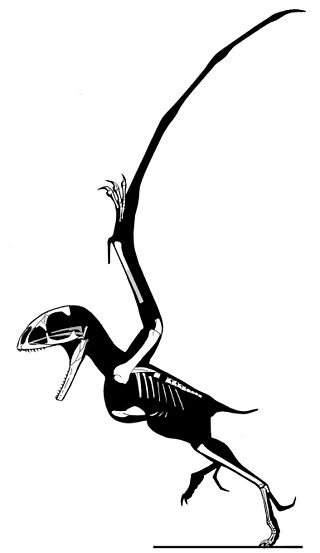
Batrachognathus is an extinct genus of anurognathid pterosaur from the Late Jurassic Karabastau Formation of the central Asian republic of Kazakhstan. The genus was named in 1948 by the Russian paleontologist Anatoly Nicolaevich Ryabinin. The type species is Batrachognathus volans. The genus name is derived from Greek batrakhos, "frog" and gnathos, "jaw", in reference to the short wide head. The specific epithet means "flying" in Latin.
Jurodidae is a family of beetles that was originally described for the extinct genus Jurodes, known from the Middle-Late Jurassic of Asia. In 1996, a living species, Sikhotealinia zhiltzovae was discovered in the Sikhote-Alin mountains in Siberia, and assigned to this family. Their placement is uncertain, but are usually considered archostematans. In one study, Sikhotealinia and Jurodes were considered a sister group to all other archostematan beetles. However, other authors have considered them to mix characteristics of Archostemata, as well as Polyphaga and Adephaga.
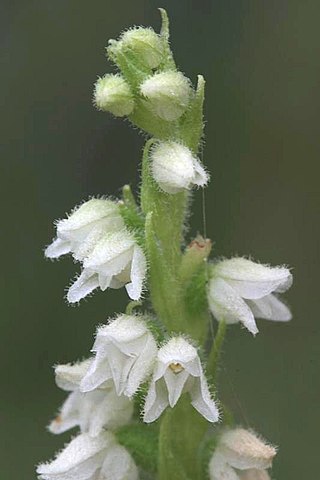
Goodyera, commonly called rattlesnake plantain, jade orchids or ladies' tresses is a wide-ranging genus of orchids in the tribe Cranichideae. About 100 species of Goodyera have been formally described. With a center of diversity in East Asia, Goodyera is found across Europe, Madeira, North and Central America, Australia, and on islands from the west Indian Ocean to the Pacific Ocean. They have a rosette of leaves at their base and usually many small white resupinate flowers. They are similar to orchids in the genus Spiranthes but can be distinguished from them by the shape and colour patterns of the leaves.
Nanningosaurus is a genus of hadrosaurid dinosaur from the upper Late Cretaceous of the Nalong Basin, Guangxi, China.
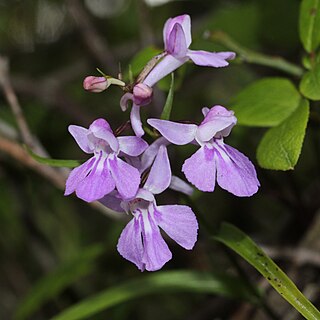
Ponerorchis is a genus of Asian terrestrial tuberous orchids. It is native to temperate Eurasia, from Poland to Japan, to the north of the Indian subcontinent and to northern Indochina.
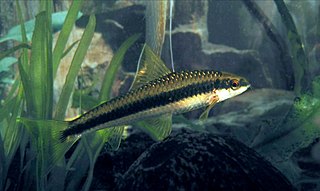
Labeoninae is a doubtfully distinct subfamily of ray-finned fishes in the family Cyprinidae of order Cypriniformes. They inhabit fresh water and the largest species richness is in the region around southern China, but there are also species elsewhere in Asia, and some members of Garra and Labeo are from Africa. They are a generally very apomorphic group, perhaps the most "advanced" of the Cyprinidae. A common name for these fishes is labeonins or labeoins.

Allocetraria is a genus of lichenized fungi in the family Parmeliaceae. It consists of 12 species, with a center of distribution in China.
Triangularia is a genus of fungi in the family Podosporaceae.
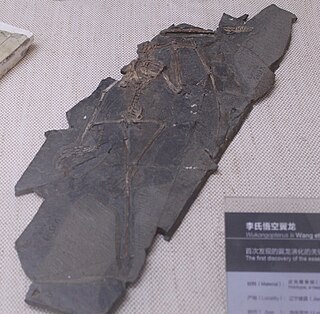
Wukongopterus is a genus of basal pterosaur, found in Liaoning, China, from the Daohugou Beds, of the Middle or Late Jurassic. It was unusual for having both an elongate neck and a long tail.

Pestalotiopsis is a genus of ascomycete fungi in the Sporocadaceae family.
Ningyuansaurus is a basal oviraptorosaurian dinosaur genus. It contains the single species Ningyuansaurus wangi, known from a fossil specimen from the Early Cretaceous Yixian Formation of Jianchang, western Liaoning Province, People's Republic of China. It is thought to be the basalmost species of oviraptorosaur, based on its long skull and a greater number of teeth in comparison to any other known oviraptorosaur. The generic name Ningyuansaurus is derived from Ningyuan, an ancient name for Xingcheng City. The specific name honors Wang Qiuwu, the private owner of the specimen who donated it for scientific study. The specimen is now in the Confuciusornis Museum in Xingcheng.

Primulina is a genus of flowering plants in the African violet family Gesneriaceae. In 2011 the genus was expanded with the transfer of many species that had previously been placed in the genus Chirita. In 2016, five species were moved to the genus Deinostigma.

This timeline of oviraptorosaur research is a chronological listing of events in the history of paleontology focused on the oviraptorosaurs, a group of beaked, bird-like theropod dinosaurs. The early history of oviraptorosaur paleontology is characterized by taxonomic confusion due to the unusual characteristics of these dinosaurs. When initially described in 1924 Oviraptor itself was thought to be a member of the Ornithomimidae, popularly known as the "ostrich" dinosaurs, because both taxa share toothless beaks. Early caenagnathid oviraptorosaur discoveries like Caenagnathus itself were also incorrectly classified at the time, having been misidentified as birds.

Sagenomella keratitidis is a hyphomycete discovered as its own species in 2008 by Sung-Yaon Hsieh et al. at the Institute of Plant and Microbial Biology and the National Taiwan University Hospital.
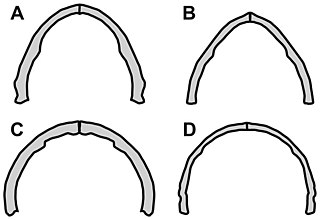
Vesperopterylus is a genus of anurognathid pterosaur from the Early Cretaceous Jiufotang Formation of China, the geologically youngest member of its group. Notably, Vesperopterylus appears to have a reversed first toe, which would have been suited for gripping; it was likely arboreal, climbing or clinging to tree branches with curved, sharp claws. It also has a relatively short tail, in contrast with its tailless (Jeholopterus) and long-tailed (Dendrorhynchoides) relatives. It was first described and named by Lü Junchang et al. While the original spelling of the name was Versperopterylus, this was a typo, and was emended by the authors in accordance with the International Code of Zoological Nomenclature.
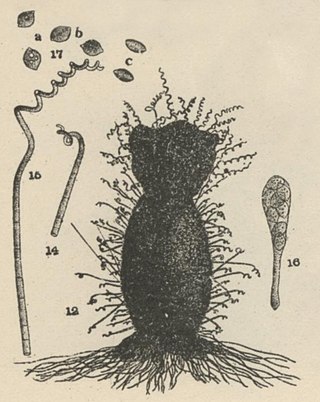
Chaetomium subspirale is a fungus from the phylum Ascomycota. It was described by A. H. Chivers in 1912 in America. The species has sexual fruiting bodies that are ornamented with characteristic, coiled hairs giving it a wooly appearance. C. subspirale colonies are brown, which the characteristic hairs are also responsible for. It is commonly found in various soil and dung samples. C. subspirale produces the mycotoxin, oxaspirodion, which inhibits inducible TNF-a expression and inhibits the activation of the transcription factor NF-kappaB.
Collariella is a genus of fungi in the family Chaetomiaceae.

Yuzhoulong is a genus of macronarian sauropod dinosaur from the Middle Jurassic Shaximiao Formation of Chongqing, China. The type and only species is Yuzhoulong qurenensis.
Phialocephala is a genus of fungi in the family Mollisiaceae. It has a worldwide distribution. It contains 39 accepted species and numerous undescribed taxa.













